


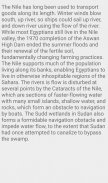

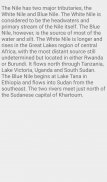
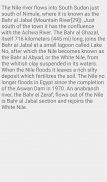
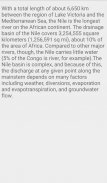
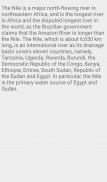

Nile River In Africa

Description of Nile River In Africa
The Nile (Arabic: النيل, written as al-Nīl; pronounced as an-Nīl) is a major north-flowing river in northeastern Africa, and is the longest river in Africa and the disputed longest river in the world, as the Brazilian government claims that the Amazon River is longer than the Nile. The Nile, which is about 6,650 km (4,130 mi)[n 1] long, is an "international" river as its drainage basin covers eleven countries, namely, Tanzania, Uganda, Rwanda, Burundi, the Democratic Republic of the Congo, Kenya, Ethiopia, Eritrea, South Sudan, Republic of the Sudan and Egypt. In particular, the Nile is the primary water source of Egypt and Sudan.
The Nile has two major tributaries, the White Nile and Blue Nile. The White Nile is considered to be the headwaters and primary stream of the Nile itself. The Blue Nile, however, is the source of most of the water and silt. The White Nile is longer and rises in the Great Lakes region of central Africa, with the most distant source still undetermined but located in either Rwanda or Burundi. It flows north through Tanzania, Lake Victoria, Uganda and South Sudan. The Blue Nile begins at Lake Tana in Ethiopia[9] and flows into Sudan from the southeast. The two rivers meet just north of the Sudanese capital of Khartoum.
The northern section of the river flows north almost entirely through the Sudanese desert to Egypt, then ends in a large delta and flows into the Mediterranean Sea. Egyptian civilization and Sudanese kingdoms have depended on the river since ancient times. Most of the population and cities of Egypt lie along those parts of the Nile valley north of Aswan, and nearly all the cultural and historical sites of Ancient Egypt are found along river banks.
Etymology and names
The standard English names "White Nile" and "Blue Nile", to refer to the river's source, derive from Arabic names formerly applied only to the Sudanese stretches which meet at Khartoum.
In the ancient Egyptian language, the Nile is called Ḥ'pī (Hapy) or Iteru, meaning "river". In Coptic, the word, pronounced piaro (Sahidic) or phiaro (Bohairic), means "the river" (lit. p(h).iar-o "the.canal-great"), and comes from the same ancient name.
In Egyptian Arabic, the Nile is called en-Nīl while in Standard Arabic it is called an-Nīl. In Biblical Hebrew: הַיְאוֹר, Ha-Ye'or or הַשִׁיחוֹר, Ha-Shiḥor.
The English name Nile and the Arabic names en-Nîl and an-Nîl both derive from the Latin Nilus and the Ancient Greek Νεῖλος. Beyond that, however, the etymology is disputed. Hesiod at his Theogony refers that Nilus (Νεῖλος) was one of the Potamoi (river gods), son of Oceanus and Tethys. Another derivation of Nile might be related to the term Nil (Sanskrit: नील, romanized: nila; Egyptian Arabic: نيلة), which refers to Indigofera tinctoria, one of the original sources of indigo dye; or Nymphaea caerulea, known as "The Sacred Blue Lily of the Nile", which was found scattered over Tutankhamen’s corpse when it was located in 1922.
Another possible etymology derives it from a Semitic Nahar, meaning "river".
With a total length of about 6,650 km (4,130 mi)[n 1] between the region of Lake Victoria and the Mediterranean Sea, the Nile is the longest river on the African continent. The drainage basin of the Nile covers 3,254,555 square kilometers (1,256,591 sq mi), about 10% of the area of Africa. Compared to other major rivers, though, the Nile carries little water (5% of the Congo's river, for example). The Nile basin is complex, and because of this, the discharge at any given point along the mainstem depends on many factors including weather, diversions, evaporation and evapotranspiration, and groundwater flow.
Above Khartoum, the Nile is also known as the White Nile, a term also used in a limited sense to describe the section between Lake No and Khartoum. At Khartoum the river is joined by the Blue Nile.























